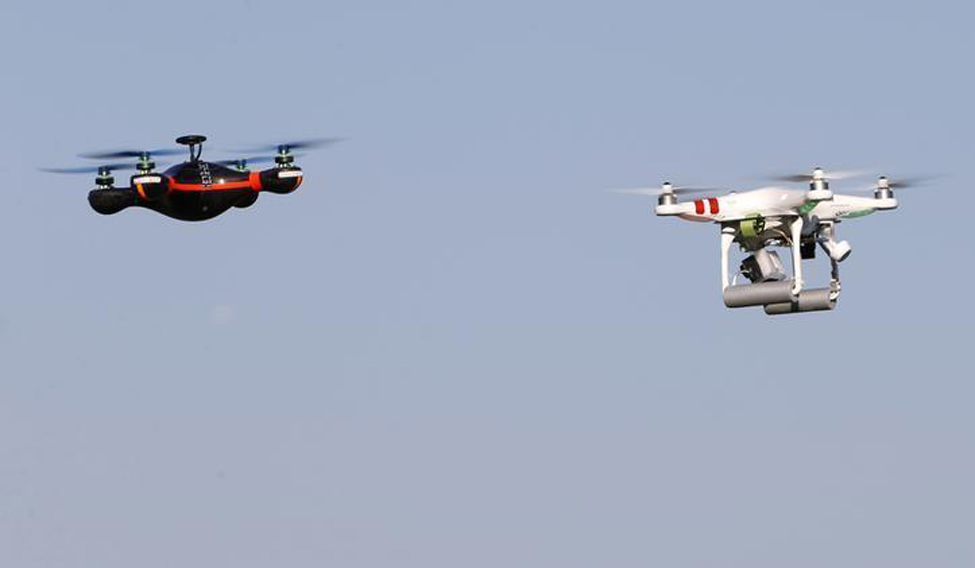Was the Lashkar-e-Taiba procuring paragliders and equipping its operatives with paragliding engine and clothes to carry out terror strikes? This was a question that bothered the Intelligence agencies in 2015. Security sources said that multiple inputs about Lashkar's interest in providing aerial training to its cadres were available to the agencies following the 26/11 terror attacks in Mumbai.
The recent drone scare in Delhi that halted operations at the IGI airport for around two hours on last Sunday has once again brought back the memories of such concerns for the security establishment.
Officials said the security threat arises from unregulated operation of microlight aircraft, powered hang-gliders, hot air balloons, paragliders and Unmanned Aerial Vehicles needs to be addressed immediately.
The interrogation of LeT's Syed Zaibuddin Ansari alias Abu Jundal, a co-conspirator in the 26/11 attacks, had revealed the terror group's interest in training its cadres with paragliding equipment besides honing their capabilities for aerial strikes. When intelligence inputs flowed in 2015 about Lashkar cadres purchasing such equipment, possibly sourcing from paragliding companies in the UAE and China, the home ministry was on its toes.
Officials said the global terror outfit has displayed its naval capabilities and it would be prudent to be wary of their aerial capabilities as well. Of course, it was something the intelligence brass could not dismiss completely.
The issue once again demanded some brainstorming following the terror strike at Pathankot airbase in January last year.
The MHA and various stakeholders had closed door meetings where the need for guarding the air space from possible threats came up for discussion. The role of a centralised agency in licensing and monitoring of UAVs was highlighted even as officials said a special focus also needs to be laid on unused airstrips in the country which could be used for such ariel strikes.
Sunday's air scare cannot be seen as an isolated one. It has come as a wake up call for the home and civil aviation ministries which have been toying with the idea of drafting a drone policy for some years now.
As of now, the aircraft rules do not cover registration, sales, purchase and flying of drones. The Directorate General of Civil Aviation has restricted the civilian use of drones or unmanned aircraft systems (UAS) through a public notice issued in October 2014. Meanwhile, the DGCA is also in the process of developing an interim operations guideline for civil use of the UAS.
In a reply to a question in Parliament on the issue in march last year, minister of state for home Haribhai Chaudahry had said that till such regulations were issued by the DGCA, "no non-government agency, organisation or individual is allowed to launch a UAS/ drone in Indian civil airspace for any purpose whatsoever. "
On Sunday, the pilot of an international airline noticed a drone from 1.5 nautical miles in the height of above 500 meter while the flight was landing at the Delhi airport. In the evening, there was another alarm raised by the pilot of a domestic airline.
The MHA has been sensitising the states on the matter time and again saying that such flying objects must not intrude into the air space beyond the authorised licenced area of operation and that such unregulated adventure flying needs proper monitoring. The MHA also wants that authorised users should not be allowed to carry any weapon or photography/video recording equipment while operating the microlight aircraft, hang gliders or hot air balloons.
But in the absence of a formal drone policy, buying and selling and flying drones is largely going un-monitored.
It was in December 2015, when Union Home Secretary Rajiv Mehrishi said that the government is preparing itself to deal with threats from "rogue elements" who could carry out terror attacks using low flying objects. He said there was a need to regulate UAVs to prevent their misuse in sensitive areas like airports. Speaking at a seminar on India's Internal Security and UAVs, Mehrishi said that the detection and destruction of UAVs is an evolving process as it leaves little or no footprint, and one does not know the extent of damage it can cause in its flying area if it is destroyed. But the government is looking at a dual aspect of enabling features like licensing it for its use on the borders as well as in guarding vital installations inside the country and disaster relief works. Secondly, the policy should have preventive features to ensure that there is no misuse by terrorist groups or other anti-national elements.
But till the time the rules and regulations are strictly in place, government sources said the scares like these will be unavoidable.





